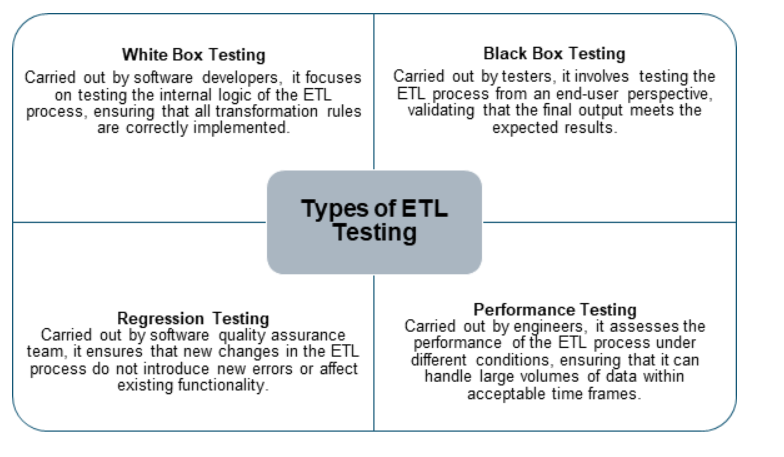
Have you ever made a business decision based on inaccurate or incomplete data? In today’s data-driven world, the quality and reliability of your data can make or break your business strategy. As organizations increasingly rely on data to guide their decisions, ensuring that this data is accurate, consistent and trustworthy is more critical than ever. This is where ETL (Extract, Transform, Load) testing comes into play.
ETL processes are essential for moving data from various sources into a unified system, but without rigorous testing, even small errors in these processes can lead to significant data quality issues. This blog highlights the best practices, common challenges and innovative solutions for optimizing ETL testing, helping you safeguard the integrity of your data and make decisions with confidence.
Unleashing the Power of ETL Testing
ETL testing stands as a cornerstone of data quality assurance. It serves as the gatekeeper for data integrity throughout the entire data pipeline. Listed below are some reasons why ETL testing is crucial:
- Data Accuracy Validation: Meticulously verifies that data transformation is executed correctly, ensuring that the data loaded into target systems is accurate and reliable.
- Business Rule Compliance: Confirms that the data adheres to predefined business rules and standards, maintaining consistency across the organization.
- Data Integration Assurance: Validates the seamless integration of data from disparate sources, crucial for comprehensive business intelligence and analytics.
- Error Detection and Prevention: By identifying issues early in the data pipeline, ETL testing prevents the propagation of errors that could lead to costly business decisions.
- Data Governance Support: It plays a vital role in maintaining data governance policies by ensuring data quality, security and compliance throughout the ETL process.
Challenges in Achieving Data Quality
- Data Volume and Variety: Massive data volumes and diverse formats challenge traditional testing methods, causing resource constraints and necessitating varied validation approaches.
- Complex Transformations: Intricate data transformations with multiple rules and edge cases create numerous data paths, making comprehensive testing difficult.
- Time Constraints: Real-time data processing demands rapid validation, often leading to compromises in test coverage due to time pressures.
- Environment Discrepancies: Differences between test and production environments can mask performance issues and cause unexpected behavior in production.
- Lack of End-to-end Visibility: Tracing data through complex ETL processes is challenging and inadequate monitoring can leave quality issues undetected.
- Evolving Data Landscape: Frequent addition of new data sources and changing regulations require constant updates to ETL processes and testing procedures.
Strategies for Obtaining Production-like Data
To ensure the effectiveness of ETL testing, it’s crucial to work with data that closely resembles production data. Here are some strategies to achieve production-like data efficiently:
- Data Sub-setting: Create representative subsets of production data that maintain the characteristics and complexities of the full dataset.
- Data Masking: Implement robust data masking techniques to protect sensitive information while preserving the data’s statistical properties.
- Synthetic Data Generation: Utilize advanced algorithms to generate synthetic data that mirrors the patterns and distributions of production data.
- Incremental Data Refresh: Update test data with fresh production data to ensure relevance and capture new data patterns.
- Virtual Data Copies: Leverage database virtualization technologies to create lightweight, up-to-date copies of production data for testing.
- Data Profiling and Analysis: Conduct thorough data profiling to understand the characteristics of production data and replicate them in test environments.
Best Practices for ETL Testing
- Establish Clear Test Objectives: Define specific, measurable goals for each testing phase to ensure comprehensive coverage.
- Implement Version Control: Use version control systems to track changes in ETL processes and test cases, facilitating easier troubleshooting and rollbacks.
- Automate Repetitive Tests: Leverage test automation tools to execute routine tests, freeing up resources for more complex testing scenarios.
- Prioritize Test Cases: Focus on critical data elements and high-risk areas to maximize the impact of testing efforts.
- Implement Continuous Testing: Integrate testing throughout the development lifecycle to discover and address issues early.
- Document Thoroughly: Maintain detailed documentation of test cases, results and any data quality issues discovered during testing.
- Collaborate Across Teams: Foster close collaboration between data engineers and testers.
Types of ETL Testing
ETL testing is categorized into different types, each targeting specific aspects of the data pipeline.
Benefits of Automated ETL Testing
As organizations struggle with increasing data volumes, complex transformations and the need for rapid insights, test automation stands out as an example of efficiency and reliability. With automation, organizations can experience the following benefits:
- Increased Test Coverage: Allows for more comprehensive testing across a wider range of scenarios and data variations.
- Faster Execution: Automated tests can be run quickly and frequently, enabling rapid identification of issues.
- Consistency and Reliability: Eliminates human errors and ensures consistent execution of test cases.
- Scalability: Provides the ability to scale up or down effortlessly, which is particularly advantageous for managing peak loads or fluctuating testing requirements.
- Improved Efficiency and Flexibility: Automated ETL testing improves efficiency and enables quick iterations and testing by freeing testers for complex tasks and enhancing flexibility.
- Early Detection of Issues: Continuous automated testing throughout the development process helps identify problems earlier, reducing the cost of fixes.
- Enhanced Reporting: Automated testing tools often provide detailed reports and analytics, offering deeper insights into test results and trends.
- Easier Maintenance: Well-designed automated tests are easier to update and maintain as ETL processes evolve.


